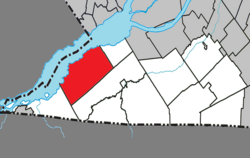Saint-Anicet
Municipality in Quebec, Canada From Wikipedia, the free encyclopedia
Municipality in Quebec, Canada From Wikipedia, the free encyclopedia
Saint-Anicet is a municipality in Le Haut-Saint-Laurent Regional County Municipality in the Montérégie administrative region of Quebec. The population as of the Canada 2021 Census was 2,754.
Saint-Anicet | |
|---|---|
 | |
 Location within Le Haut-Saint-Laurent RCM | |
| Coordinates: 45°07′N 74°21′W[1] | |
| Country | Canada |
| Province | Quebec |
| Region | Montérégie |
| RCM | Le Haut-Saint-Laurent |
| Constituted | July 1, 1855 |
| Government | |
| • Mayor | Gino Moretti |
| • Federal riding | Salaberry—Suroît |
| • Prov. riding | Huntingdon |
| Area | |
| • Total | 179.52 km2 (69.31 sq mi) |
| • Land | 135.03 km2 (52.14 sq mi) |
| Population (2021)[4] | |
| • Total | 2,754 |
| • Density | 20.4/km2 (53/sq mi) |
| • Pop (2016-21) | |
| • Dwellings | 1,913 |
| Time zone | UTC−5 (EST) |
| • Summer (DST) | UTC−4 (EDT) |
| Postal code(s) | |
| Area code(s) | 450 and 579 |
| Highways | |
| Website | www |
Saint-Anicet is located in the southwestern Montérégie region of Quebec, on the south shore of the Saint Lawrence River.

In addition to the namesake main population centre, the following locations reside within the municipality's boundaries:[1]
The following waterways pass through or are situated within the municipality's boundaries:[1]
In 1788, the geographic township of Godmanchester was surveyed, and by 1795, a group of Acadians had settled in the area, followed by Irish and French Canadians. In 1810, a mission was established, named after Pope Anicetus. It became the Parish of Saint-Anicet-de-Godmanchester in 1827. In 1851, its post office opened.[1]
On July 1, 1845, the Parish Municipality of Saint-Anicet was formed, but merged into the Municipality of Beauharnois Number Two on September 1, 1847 (along with Dundee, Hinchinbrooke, Hemmingford, Godmanchester, Russeltown, and Ormstown). It was reestablished on July 1, 1855.[1][5]
On December 10, 2011, the parish municipality changed statutes to become a regular municipality.[1][5]
| 2021 | 2016 | 2011 | |
|---|---|---|---|
| Population | 2,754 (+4.9% from 2016) | 2,626 (+4.1% from 2011) | 2,523 (-7.1% from 2006) |
| Land area | 135.03 km2 (52.14 sq mi) | 135.33 km2 (52.25 sq mi) | 135.16 km2 (52.19 sq mi) |
| Population density | 20.4/km2 (53/sq mi) | 19.4/km2 (50/sq mi) | 18.7/km2 (48/sq mi) |
| Median age | 55.2 (M: 55.6, F: 55.2) | 52.8 (M: 53.5, F: 52.3) | 51.9 (M: 52.8, F: 50.9) |
| Private dwellings | 1,913 (total) 1,309 (occupied) | 2,088 (total) | 1,965 (total) |
| Median household income | $66,500 | $50,528 | $42,911 |
|
|
|
| Canada Census Mother Tongue Language - Saint-Anicet, Quebec[11] | ||||||||||||||||||
|---|---|---|---|---|---|---|---|---|---|---|---|---|---|---|---|---|---|---|
| Census | Total | French |
English |
French & English |
Other | |||||||||||||
| Year | Responses | Count | Trend | Pop % | Count | Trend | Pop % | Count | Trend | Pop % | Count | Trend | Pop % | |||||
2021 |
2,755 |
2,185 | 79.3% | 415 | 15.1% | 85 | 3.1% | 60 | 2.2% | |||||||||
2016 |
2,625 |
2,125 | 81.0% | 395 | 15.1% | 50 | 1.9% | 50 | 1.9% | |||||||||
2011 |
2,525 |
2,040 | 80.8% | 395 | 15.6% | 40 | 1.6% | 50 | 2.0% | |||||||||
2006 |
2,715 |
2,250 | 82.9% | 310 | 11.4% | 45 | 1.7% | 110 | 4.1% | |||||||||
2001 |
2,590 |
2,060 | 79.5% | 355 | 13.7% | 80 | 3.1% | 95 | 3.7% | |||||||||
1996 |
2,520 |
2,005 | n/a | 79.6% | 450 | n/a | 17.9% | 30 | n/a | 1.2% | 35 | n/a | 1.4% | |||||
List of former mayors:[5]

In the south of Saint-Anicet, the Tsiionhiakwatha/Droulers archaeological site interpretation center is where an important Iroquoian village in Quebec was located. Circa 1450, approximately 500 St.Lawrence Iroquoians established a village near the La Guerre River. The centre opened on May 15, 2010.[12]
Droulers-Tsiionhiakwatha was designated a Site du patrimoine constitué under provincial legislation in 2005,[13] and a National Historic Site of Canada in 2007.[14]
Seamless Wikipedia browsing. On steroids.
Every time you click a link to Wikipedia, Wiktionary or Wikiquote in your browser's search results, it will show the modern Wikiwand interface.
Wikiwand extension is a five stars, simple, with minimum permission required to keep your browsing private, safe and transparent.